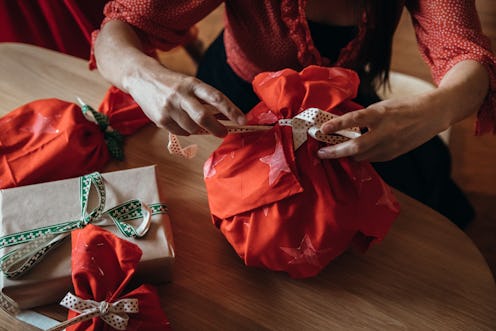Christmas
For your most sustainable festive season yet.

Christmas is all about spending time with your loved ones, getting into the festive spirit, and having the occasional argument with a distant, problematic family member over the roast turkey. But let’s be honest, Christmas has also become a bit consumerist. And when you’re having a good time, sustainability and environmentalism at Christmas tend to go left at the wayside.
It’s easy to end up giving into fast fashion and ordering your fourth new Christmas jumper, or perhaps giving up on the recycling when you’re ripping into at a pile of presents, half of which you might never use. While we’re enjoying this season, let’s not forget the impact our Christmas habits can have on the planet.
According to the packaging company GWP Group, 125,000 tonnes of plastic wrapping used for food will be discarded over Christmas. Around 1 billion Christmas cards could end up in the bin after Christmas day, and 83 square kilometres of wrapping paper will be thrown out or burnt. Just because it’s a time of holiday cheer that doesn’t mean you have to throw the future of the planet in the bin with the leftovers. So, here are some tips and tricks on how to have a more sustainable Christmas.
Christmas trees
The real versus fake Christmas tree debate is a tricky one. As Bustle has previously reported, a two-metre artificial Christmas tree has a carbon footprint equivalent to 40kg of greenhouse gas emissions due to the way in which it is manufactured (fake trees are most often made from plastic). That is more than twice that of a real tree that ends its life in landfill and more than ten times that of a real tree that is burnt.It also means you would have to use if for at least 12 years to make it more sustainable than a real tree which is recycled after use.
However, real Christmas trees also have their problems.. In fact, 8 million trees are thrown out each year after Christmas. If you have a reusable tree, keep using it. If you don't, it may be time to consider other options. For example, you could decorate an existing house plant. If you do end up getting a real tree, make sure it’s properly collected and recycled.
Recycling
During Christmas, there’s lots of presents, which means even more wrapping paper. This year, perhaps you can use reusable fabric wrapping paper, or reuse wrapping paper from presents gifted to you!
Due to surplus food and decorations, there’s generally lots of packaging waste too. Try not to be slack with the recycling just because it's Christmas. Find out how you to recycle items like Christmas lights and where you can donate presents you don't fancy keeping.
Leftovers
Christmas can get a bit overindulgent. In fact, around 10 million turkeys were consumed last year. And food waste is a big problem, with 54 million platefuls of food wasted over the festive period. So why not come up with some imaginative leftover recipes, like turkey and cranberry spring rolls, for example?
Presents
Not only can this time of year be a bit of a financial burden, but it can also produce waste through unwanted gifts. You could consider buying second-hand gifts for family or friends, or instead of purchasing lots of presents, try doing a secret Santa. That way, you’ll only need to purchase one well-thought-out present and only receive one too. Or you could even go that one step further and go present-free by treating your loved ones to experiences rather than a physical item.
Crackers
Crackers, and Christmas, in general, are very sparkly — but all that glitter comes at a cost. According to the National Geographic glitter is a type of microplastic and can find its way into the ocean destroying sea life. You might think crackers are already eco-friendly and fine to chuck in the recycling along with the festive wrapping paper. After all, it’s just made of card with a paper hat. But from the plastic toys to the unrecyclable glitter, Christmas crackers aren’t all that great for the environment. So this year might be the time to try out some eco-friendly Christmas cracker ideas.
This article was originally published on